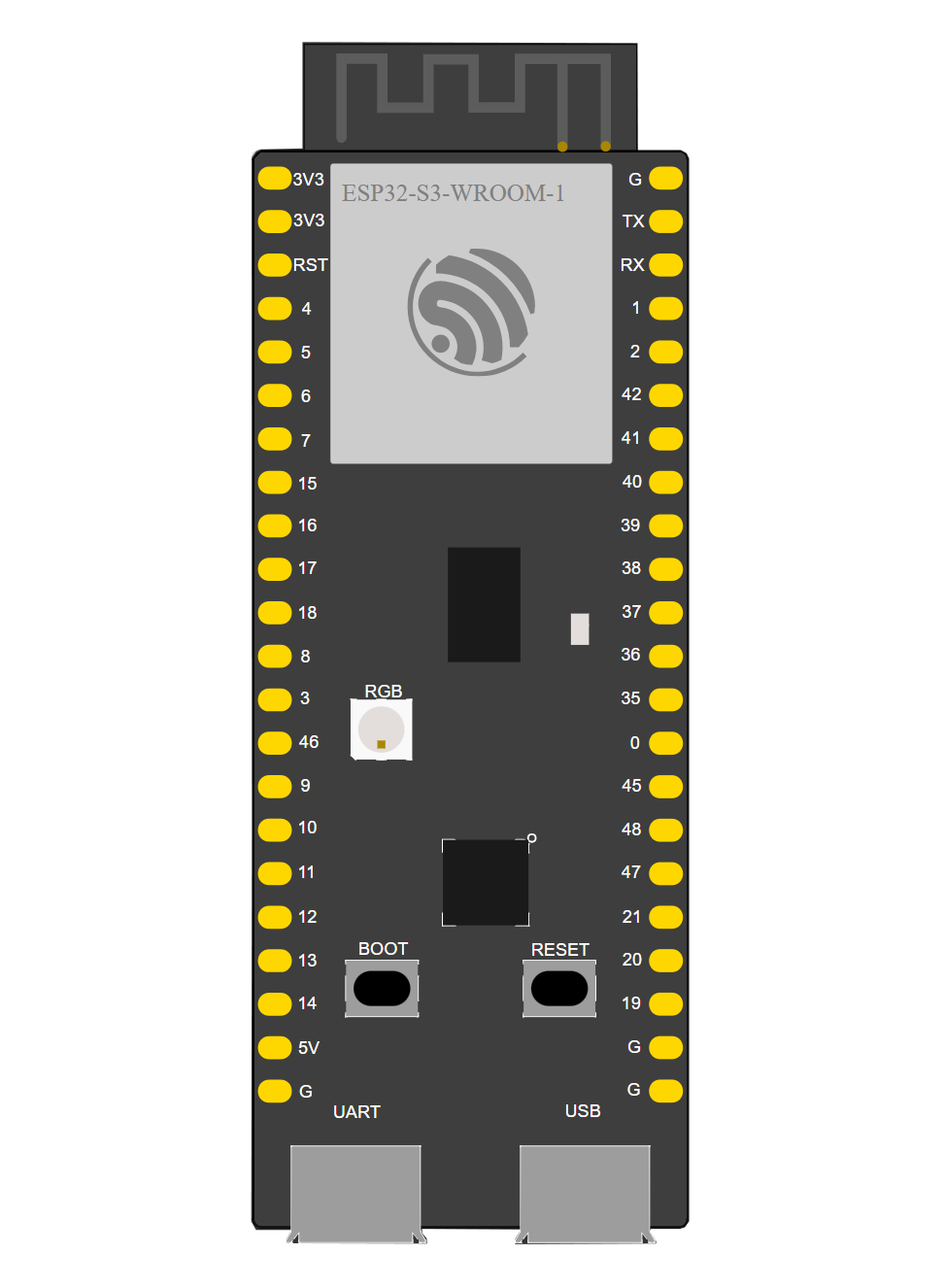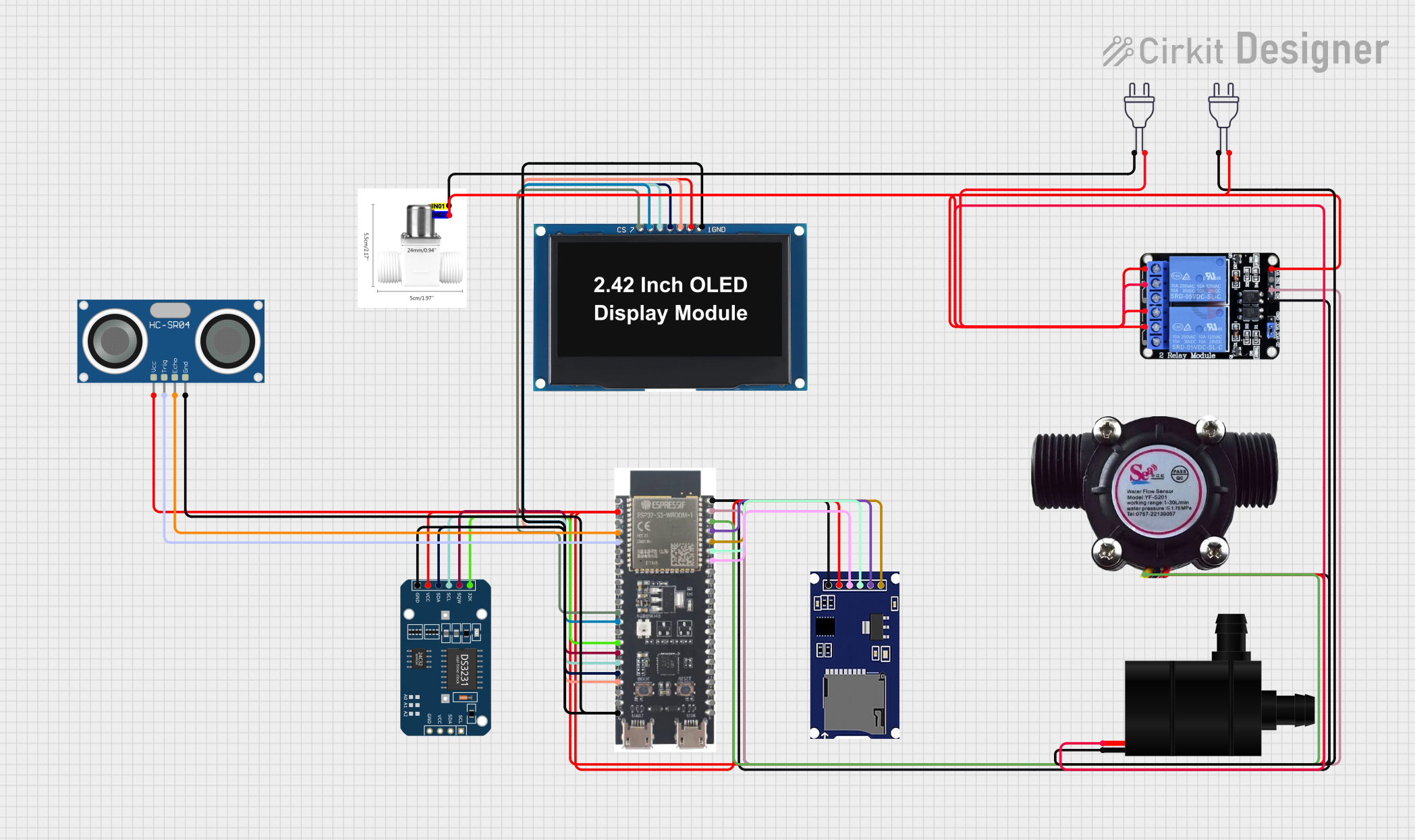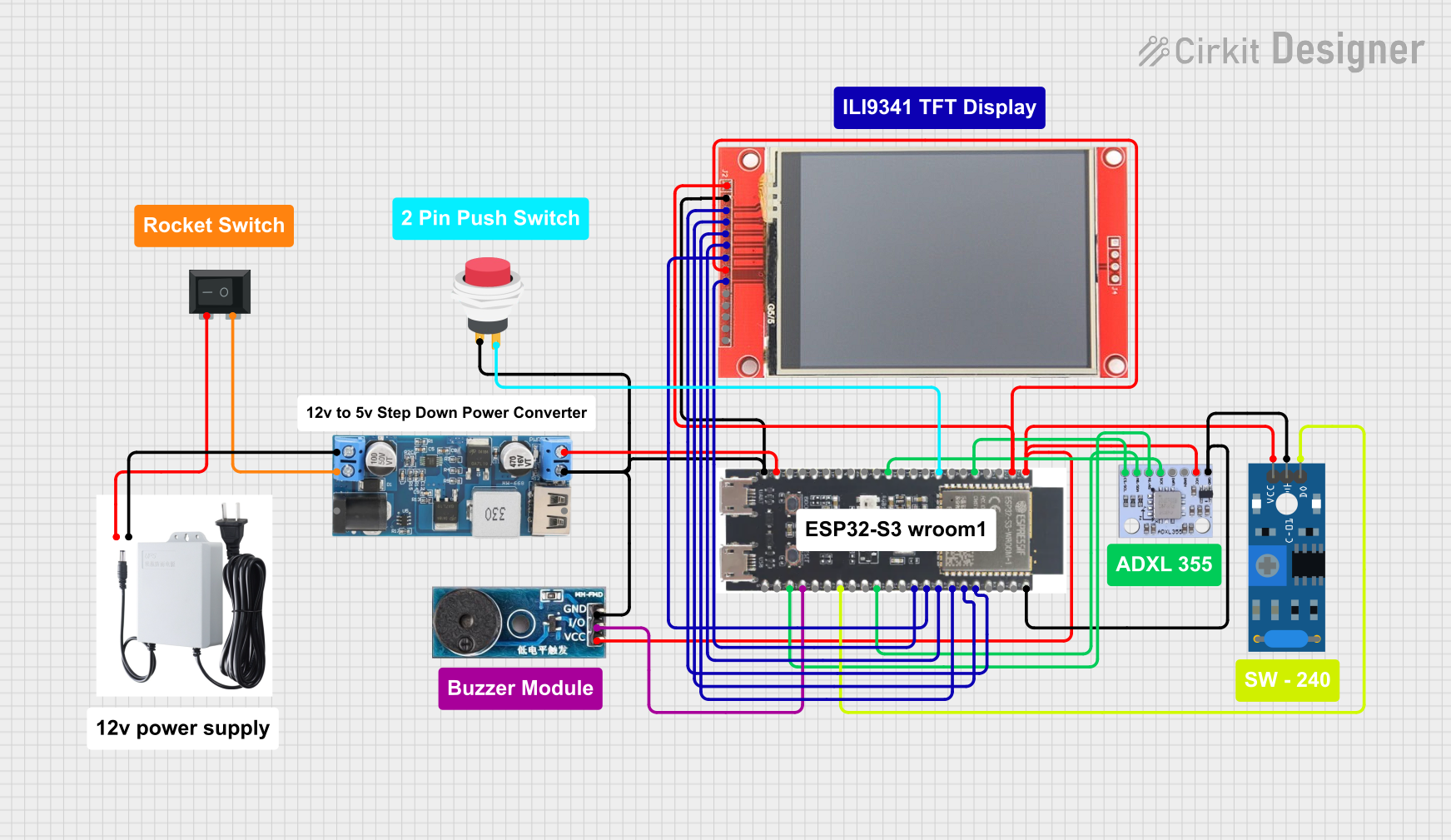
How to Use ESP32-S3: Examples, Pinouts, and Specs

 Design with ESP32-S3 in Cirkit Designer
Design with ESP32-S3 in Cirkit DesignerIntroduction
The ESP32-S3 is a high-performance, low-power system on a chip (SoC) manufactured by Automata. It is designed for Internet of Things (IoT) applications and features integrated Wi-Fi and Bluetooth capabilities. With its dual-core processor, enhanced AI acceleration, and a wide range of peripherals, the ESP32-S3 is ideal for complex tasks, real-time applications, and edge computing.
Explore Projects Built with ESP32-S3

 Open Project in Cirkit Designer
Open Project in Cirkit Designer
 Open Project in Cirkit Designer
Open Project in Cirkit Designer
 Open Project in Cirkit Designer
Open Project in Cirkit Designer
 Open Project in Cirkit Designer
Open Project in Cirkit DesignerExplore Projects Built with ESP32-S3

 Open Project in Cirkit Designer
Open Project in Cirkit Designer
 Open Project in Cirkit Designer
Open Project in Cirkit Designer
 Open Project in Cirkit Designer
Open Project in Cirkit Designer
 Open Project in Cirkit Designer
Open Project in Cirkit DesignerCommon Applications and Use Cases
- IoT Devices: Smart home systems, industrial IoT, and connected appliances.
- AI and Machine Learning: Edge AI applications, voice recognition, and image processing.
- Wearable Devices: Fitness trackers, smartwatches, and health monitoring systems.
- Embedded Systems: Robotics, automation, and sensor networks.
- Wireless Communication: Wi-Fi and Bluetooth-enabled devices for data transfer and control.
Technical Specifications
Key Technical Details
| Parameter | Specification |
|---|---|
| Manufacturer | Automata |
| Part ID | ESP32 |
| Processor | Dual-core Xtensa® LX7 (up to 240 MHz) |
| AI Acceleration | Vector instructions for AI/ML workloads |
| Wireless Connectivity | Wi-Fi 802.11 b/g/n (2.4 GHz), Bluetooth 5.0 LE |
| Flash Memory | Up to 16 MB external flash |
| SRAM | 512 KB internal SRAM, with support for external PSRAM |
| GPIO Pins | 45 GPIOs (configurable for various functions) |
| Operating Voltage | 3.0V to 3.6V |
| Power Consumption | Ultra-low power modes for battery-powered applications |
| Peripherals | SPI, I2C, UART, ADC, DAC, PWM, SDIO, CAN, Ethernet, and more |
| Operating Temperature | -40°C to +85°C |
| Package | QFN48 or QFN68 |
Pin Configuration and Descriptions
The ESP32-S3 has a flexible pinout with up to 45 GPIOs. Below is a summary of key pins:
| Pin Name | Function | Description |
|---|---|---|
| VDD | Power Supply | Connect to 3.3V power supply. |
| GND | Ground | Connect to ground. |
| GPIO0 | Boot Mode Selection | Used for boot mode selection during programming. |
| GPIO1-45 | General Purpose I/O | Configurable for digital I/O, ADC, DAC, PWM, I2C, SPI, UART, etc. |
| EN | Chip Enable | Active high. Pull low to reset the chip. |
| TXD0/RXD0 | UART0 TX/RX | Default UART for programming and debugging. |
| ADC1/ADC2 | Analog-to-Digital Converter Pins | Used for analog input (12-bit resolution). |
| DAC1/DAC2 | Digital-to-Analog Converter Pins | Used for analog output. |
| MTMS/MTDI | JTAG Debugging Pins | Used for debugging and development. |
Usage Instructions
How to Use the ESP32-S3 in a Circuit
- Power Supply: Provide a stable 3.3V power supply to the VDD pin. Ensure proper decoupling capacitors are placed near the power pins.
- Programming: Use a USB-to-UART converter to connect the ESP32-S3 to your computer. Connect:
- TXD0 to the RX pin of the converter.
- RXD0 to the TX pin of the converter.
- GPIO0 to GND during programming to enable boot mode.
- GPIO Configuration: Configure GPIO pins as needed for digital I/O, ADC, DAC, or communication protocols (SPI, I2C, UART).
- Antenna: Ensure proper placement of the onboard antenna or connect an external antenna for optimal wireless performance.
Important Considerations and Best Practices
- Power Management: Use the ultra-low power modes for battery-powered applications to extend battery life.
- Decoupling: Place decoupling capacitors (e.g., 0.1 µF) close to the power pins to reduce noise.
- Antenna Placement: Avoid placing metal objects near the antenna to prevent signal interference.
- Programming Mode: Ensure GPIO0 is pulled low during programming and released after flashing the firmware.
- Heat Dissipation: For high-performance applications, ensure proper heat dissipation to avoid thermal throttling.
Example: Connecting ESP32-S3 to Arduino IDE
The ESP32-S3 can be programmed using the Arduino IDE. Follow these steps:
- Install the ESP32 Board Manager in the Arduino IDE.
- Select the ESP32-S3 board from the Tools menu.
- Connect the ESP32-S3 to your computer via a USB-to-UART converter.
- Use the following example code to blink an LED connected to GPIO2:
// Example: Blink an LED connected to GPIO2
#define LED_PIN 2 // Define the GPIO pin for the LED
void setup() {
pinMode(LED_PIN, OUTPUT); // Set GPIO2 as an output pin
}
void loop() {
digitalWrite(LED_PIN, HIGH); // Turn the LED on
delay(1000); // Wait for 1 second
digitalWrite(LED_PIN, LOW); // Turn the LED off
delay(1000); // Wait for 1 second
}
Troubleshooting and FAQs
Common Issues and Solutions
ESP32-S3 Not Detected by Computer
- Ensure the USB-to-UART driver is installed on your computer.
- Check the connections between the ESP32-S3 and the USB-to-UART converter.
- Verify that GPIO0 is pulled low during programming.
Wi-Fi Connection Fails
- Ensure the correct SSID and password are used in your code.
- Check for interference from other devices operating on the 2.4 GHz band.
High Power Consumption
- Use the ultra-low power modes for battery-powered applications.
- Disable unused peripherals to reduce power consumption.
Program Upload Fails
- Verify that the correct board and COM port are selected in the Arduino IDE.
- Ensure GPIO0 is connected to GND during programming.
FAQs
Q: Can the ESP32-S3 be powered with 5V?
A: No, the ESP32-S3 operates at 3.3V. Using 5V can damage the chip. Use a voltage regulator if needed.
Q: How many devices can the ESP32-S3 connect to via Bluetooth?
A: The ESP32-S3 supports Bluetooth 5.0 LE and can connect to multiple devices, depending on the application.
Q: Does the ESP32-S3 support over-the-air (OTA) updates?
A: Yes, the ESP32-S3 supports OTA updates, allowing firmware to be updated wirelessly.
Q: Can I use the ESP32-S3 for AI applications?
A: Yes, the ESP32-S3 includes vector instructions optimized for AI/ML workloads, making it suitable for edge AI applications.
This concludes the documentation for the ESP32-S3. For further assistance, refer to the official datasheet or contact Automata support.